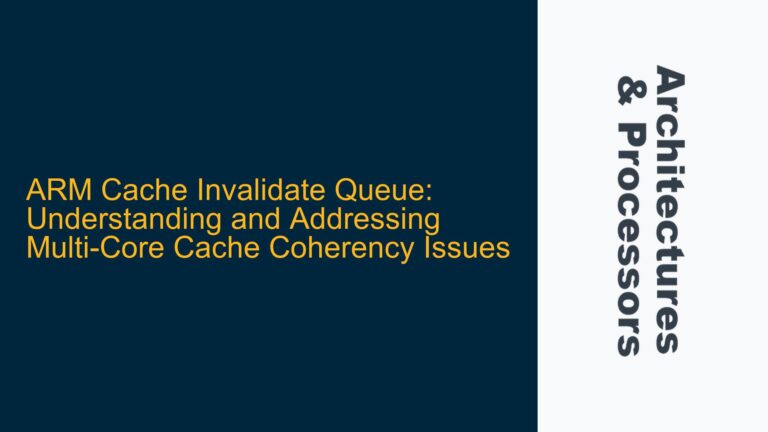AHB5 Multi-Slave Select Feature and Its Impact on Address Decoding
The AHB5 protocol introduces a significant enhancement called "Multi-Slave Select," which fundamentally changes how address decoding and slave selection are handled in ARM-based SoC designs. Unlike AHB3, where a single HSEL (Hardware Select) signal is used to select a slave device, AHB5 allows a single physical slave to have multiple HSEL inputs. This feature enables the system address decoder to inform the slave about which specific region of its address space is being accessed. For example, a slave device could have one HSEL input for accessing configuration registers and another for accessing a data array, even if these regions are located at different ends of the system address map.
In AHB3, address decoding is typically implemented using a centralized decoder and multiplexer. The decoder generates a single HSEL signal for each slave based on the address, and the multiplexer routes the appropriate data and control signals to and from the selected slave. While this approach works well for systems with a small number of slaves, it can become inefficient and complex in larger systems with multiple address regions per slave. The AHB5 Multi-Slave Select feature addresses this limitation by allowing slaves to have multiple HSEL inputs, effectively enabling finer-grained address decoding within the slave itself.
This architectural shift has several implications for SoC design. First, it simplifies the address decode logic inside the slave by distributing the decoding responsibility between the system address decoder and the slave. Second, it reduces the complexity of the interconnect fabric, as fewer signals need to be routed between the decoder and the slaves. Third, it improves system scalability by making it easier to add new address regions to existing slaves without modifying the central decoder.
However, the Multi-Slave Select feature also introduces new challenges, particularly in terms of timing, synchronization, and verification. For example, ensuring that all HSEL inputs to a slave are correctly synchronized with the AHB control signals (HADDR, HTRANS, HWRITE, etc.) can be non-trivial, especially in high-frequency designs. Additionally, the increased flexibility in address decoding can lead to more complex corner cases that need to be thoroughly verified.
Potential Timing and Synchronization Issues in AHB5 Multi-Slave Select Implementations
One of the primary challenges in implementing the AHB5 Multi-Slave Select feature is ensuring proper timing and synchronization between the multiple HSEL inputs and the AHB control signals. In AHB3, the timing relationship between the HSEL signal and the control signals is relatively straightforward, as there is only one HSEL signal per slave. However, in AHB5, each slave can have multiple HSEL inputs, each corresponding to a different address region. This introduces additional complexity in ensuring that all HSEL signals are correctly aligned with the control signals.
Timing issues can arise if the HSEL signals are not properly synchronized with the AHB control signals. For example, if an HSEL signal transitions too early or too late relative to the HADDR signal, the slave may misinterpret the address and access the wrong region. This can lead to data corruption, incorrect configuration, or even system crashes. To mitigate these risks, designers must carefully analyze the timing relationships between the HSEL signals and the control signals, taking into account factors such as clock skew, signal propagation delays, and setup/hold times.
Another potential issue is the synchronization of HSEL signals across different clock domains. In some designs, the system address decoder and the slaves may operate in different clock domains, requiring careful handling of cross-domain synchronization. Failure to properly synchronize the HSEL signals can result in metastability, where the slave incorrectly interprets the HSEL signals and accesses the wrong address region. To address this, designers can use techniques such as double-flopping or gray coding to ensure reliable cross-domain synchronization.
In addition to timing and synchronization issues, the Multi-Slave Select feature can also introduce challenges in terms of power management. In AHB3, the HSEL signal is typically used to gate the clock or power to the slave, reducing power consumption when the slave is not in use. However, in AHB5, the presence of multiple HSEL inputs complicates this approach, as the slave may need to remain powered on even if only one of its HSEL inputs is active. Designers must carefully consider the power implications of the Multi-Slave Select feature and implement appropriate power management strategies to minimize energy consumption.
Strategies for Verifying AHB5 Multi-Slave Select Functionality and Ensuring Compliance
Verifying the correct implementation of the AHB5 Multi-Slave Select feature requires a comprehensive verification strategy that addresses both functional and timing aspects. The verification process should begin with a detailed analysis of the design specifications, including the address map, the number of HSEL inputs per slave, and the expected timing relationships between the HSEL signals and the control signals. This analysis should be used to develop a verification plan that covers all possible corner cases, including edge cases where multiple HSEL inputs are active simultaneously or where the address transitions between regions.
One effective approach to verifying the Multi-Slave Select feature is to use a combination of simulation and formal verification. Simulation-based verification can be used to test the functionality of the design under a wide range of scenarios, including normal operation, boundary conditions, and error cases. Formal verification, on the other hand, can be used to prove the correctness of the design with respect to the AHB5 specification, ensuring that all timing and synchronization requirements are met.
In simulation-based verification, it is important to create a comprehensive testbench that includes models for the system address decoder, the slaves, and the interconnect fabric. The testbench should be designed to generate a wide range of test cases, including random, directed, and corner-case scenarios. Special attention should be paid to scenarios where the address transitions between regions, as this is where timing and synchronization issues are most likely to occur. The testbench should also include monitors and checkers to verify that the HSEL signals and control signals are correctly aligned and that the slaves are accessing the correct address regions.
Formal verification can be used to complement simulation-based verification by providing a mathematical proof of the design’s correctness. This is particularly useful for verifying the timing and synchronization aspects of the Multi-Slave Select feature, as formal tools can exhaustively analyze all possible timing scenarios and identify any violations of the AHB5 specification. Formal verification can also be used to verify that the design meets its power management requirements, ensuring that the slave is only powered on when necessary.
In addition to simulation and formal verification, it is also important to perform timing analysis to ensure that the design meets its timing requirements. This includes analyzing the setup and hold times for the HSEL signals and control signals, as well as the clock skew and signal propagation delays. Timing analysis should be performed using industry-standard tools, and the results should be carefully reviewed to identify and address any potential timing violations.
Finally, it is important to perform compliance testing to ensure that the design meets the AHB5 specification. This includes testing the design against the AHB5 compliance test suite, which includes a set of test cases designed to verify that the design meets all the requirements of the AHB5 protocol. Compliance testing should be performed using a combination of simulation and formal verification, and the results should be carefully reviewed to ensure that the design is fully compliant with the AHB5 specification.
In conclusion, the AHB5 Multi-Slave Select feature introduces significant architectural enhancements that improve the scalability and flexibility of ARM-based SoC designs. However, it also introduces new challenges in terms of timing, synchronization, and verification. By carefully analyzing the design specifications, developing a comprehensive verification strategy, and using a combination of simulation, formal verification, and timing analysis, designers can ensure that their AHB5-based designs are robust, reliable, and fully compliant with the AHB5 specification.






